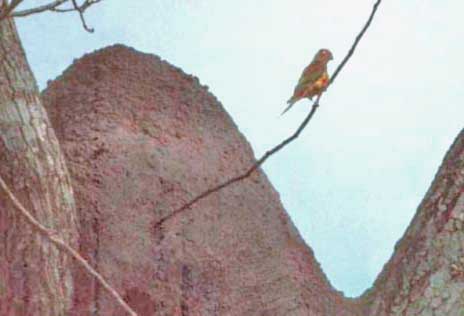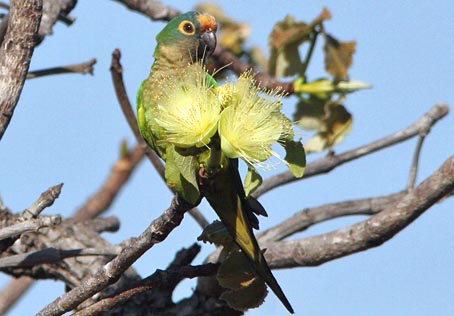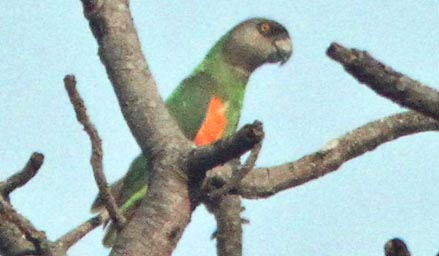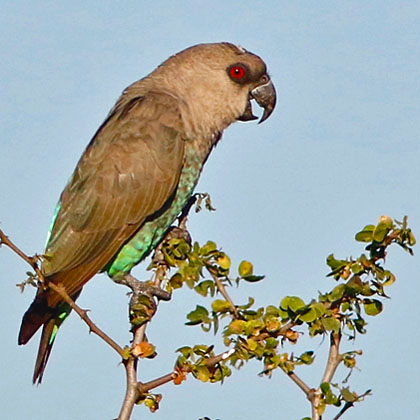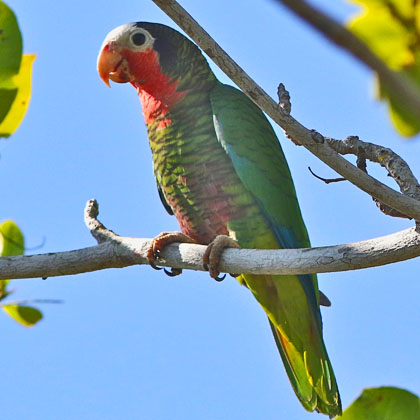| |
NEW WORLD & GRAY PARROTS Psittacidae |
- 157 species in the Neotropics and in Africa
- DR personal total: 96 species (61%), 29 photo'd
|
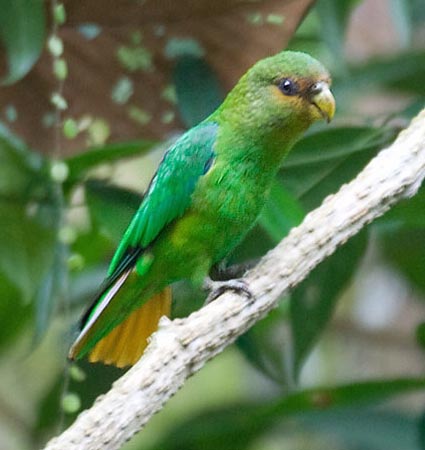 Parrots are a very large group of easily recognized birds, generally restricted to the tropics around the globe. Recent molecular evidence could be used to group the Psittaciformes into as few as 3 or 4 families, or split them into as many as a dozen families. If one chose a three-family approach — the one that I used through 12 editions of this checklist — South American macaws were in the same family as tiny pygmy-parrots. The largest macaw is 170 times heavier and twelve times longer than one of the New Guinea pygmy-parrots (Collar 1997). This was huge family of about 330 species. Now, however, following new evidence on lineages within the parrots [e.g., Schweizer et al. 2011, Joseph et al. 2013, Rheindt et al. 2014], both Cracraft (2013) and the South American Checklist Committee (2014) have adopted a four-family solution (more details are in the shaded box below). Parrots are a very large group of easily recognized birds, generally restricted to the tropics around the globe. Recent molecular evidence could be used to group the Psittaciformes into as few as 3 or 4 families, or split them into as many as a dozen families. If one chose a three-family approach — the one that I used through 12 editions of this checklist — South American macaws were in the same family as tiny pygmy-parrots. The largest macaw is 170 times heavier and twelve times longer than one of the New Guinea pygmy-parrots (Collar 1997). This was huge family of about 330 species. Now, however, following new evidence on lineages within the parrots [e.g., Schweizer et al. 2011, Joseph et al. 2013, Rheindt et al. 2014], both Cracraft (2013) and the South American Checklist Committee (2014) have adopted a four-family solution (more details are in the shaded box below).
The "new" family Psittacidae has all the New World parrots plus two African genera (Psittacus and Poicephalus; these are often called the "gray parrots"). The New World parrots plus the African "gray parrots" comprise 48% of the "traditional" parrots. The remaining 52% are now assigned to the family Psittaculidae, composed of all the Lories, Lovebirds, and all remaining Old World parrots (excepting the two African genera).
The reduced Psittacidae is still a large and interesting lot. It is exemplified by the spectacular Scarlet Macaw of the Neotropics (above) to tiny parrotlets, such as the endangered Golden-tailed Parrotlet (left) on northeastern Brazil (left in a very nice photo by Arthur Grosset). |
Traditionally, all birds in the Order Psittaciformes were placed in a single Parrot family. Then, Sibley & Ahlquist (1990) and Sibley & Monroe (1990) raised the Cockatoos to family level distinct from the other Parrots. The Handbook of the Birds of the World (Collar 1997) followed the decision. Dickinson (2003) combined them again into a single family [Psittacidae] noting, in footnotes, that various other groups (e.g., Kakapo Strigops habroptila of New Zealand, or the hanging-parrots Loriculus et al.) could also qualify for family status. Christidis & Boles (2008) reviewed the evidence and split the Psittaciformes into three families: the Nestoridae [three New Zealand parrots], the Cacatuidae [Cockatoos], and the rest of them here, in the Psitticidae. I followed that arrangement through my 12th ed. family list.
However, Joseph et al. (2012) divided the Psittaciformes into 6 families: Strigopidae (for the Kakapo,), Nestoridae (for the Kea and Kaka, Nestor, of New Zealand), Cacatuidae (cockatoos), Psittrichasidae (for Psittrichas and Coracopsis = Mascarinus), Psittacidae (for African Psittacus and Poicephalus plus all New World parrots), and Psittaculidae (for all remaining Old World parrots). Cracraft (2013) reduced this to four families: Strigopidae, Cacatuidae, Psittacidae, and Psittaculidae.
Both Schweizer et al. (2011) and Rheindt et al. (2014) offered molecular phylogenies with an analysis of divergence dates. The Rheindt et al. (2014) project not only compared mtDNA and nuclear DNA evidence, but added calibrations based on fossil evidence, thus providing independent evidence to give more confidence to the ages of divergence of lineages. It now appears that the New Zealand parrots diverged about 42–49 mya. The next split from the parrot line was the cockatoos, at about 39–45 mya. Then the main lineage of parrots split into two groups — the African "gray parrots" and all New World parrots in one group, and all remaining Old World parrots in the other group — at about 34–39 mya. The difference in these ranges depends upon whether mtDNA or nuclear DNA is calibrated by the independent fossil evidence. In any event, all available evidence now suggests that these four main psittacid lineages are the four oldest evolutionary lineages.
One could subdivide the Psittaciformes even further, but the age of divergence evidence does not support adding just the two more families suggested by Joseph et al. (2013). The New Zealand endemic Kakapo, proposed as the Strigopidae, diverged from the line of other New Zealand parrots about 27-29 mya; Rheindt et al. (2014). The study by Schweizer et al. (2011) did not include Kakapo but did include Psittrichas [the New Guinea endemic Presquet's Parrot and Coracopsis, the Madagascar vasa parrots (now Mascarinus)], and together that divergence from other Old World parrots was dated at about 34 mya. This figure may be somewhat high as Schweizer et al. (2011) show the divergence of the New Zealand parrot line to be at about 58–59 mya. When constrained by independent fossil evidence in Rheindt et al. (2014), that divergence shortened to 42–49 mya. Yet, setting aside the variance in dating divergences, the Schweizer et al. (2011) shows at least 3, and maybe 4 other divergences from the Old World parrot line before the divergence of Psittrichas/Coracopsis, including those involving Eclectus Parrot and allies, the lories, and the lovebirds. Using the combined evidence of Schweizer et al. (2011) and Rheindt et al. (2014), if one wished to split all the lineages down to Kakapo as families, one would end up with about 12 families in the Psittaciformes. |
|
|
Some parrots are among the most spectacular birds in the world, including the Hyacinth Macaw (above) of the Pantanal region of south-central South America. It is the world's largest parrot at 100 cm (~40") long and 1.7 kg (=3.75 lb) in weight. Hyacinth Macaws feed on the fruits of a small number of palms, and is quite local in the wild; fine articles on finding this wonderful bird in the Brazilian Pantanal are Ridgely (1983) and Whittingham et al. (1998). |
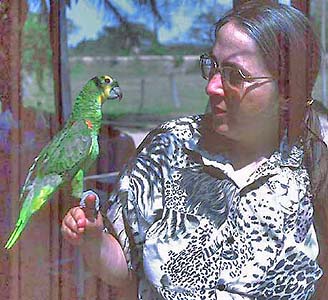 The New World has but a single tribe in a single subfamily [the Arini], at least as arranged by Collar (1997), Yet among the approximately 150 species is an astonishing variety in size, shape, and behavior. About 30 species are in the widespread New World genus Amazona; these include some of the Neotropics commonest parrots and some of the world's rarest species. "Amazon" parrots are often kept as pets; indeed, in past centuries explorers coming upon previously undiscovered native inhabitants often found they kept pet parrots in their villages. At right Rita is holding a Blue-fronted (or Turquoise-fronted) Amazon which was a pet of a local family in the Brazilian Pantanal; they had found it as a baby fallen out of its nest hole and raised it to adulthood. Such parrots can live 20-30 years. The evening flight of wild Blue-fronts in the Pantanal is truly an impressive spectacle. A wild Blue-fronted Parrot is shown (below left) foraging in the canopy of a fruiting tree. The New World has but a single tribe in a single subfamily [the Arini], at least as arranged by Collar (1997), Yet among the approximately 150 species is an astonishing variety in size, shape, and behavior. About 30 species are in the widespread New World genus Amazona; these include some of the Neotropics commonest parrots and some of the world's rarest species. "Amazon" parrots are often kept as pets; indeed, in past centuries explorers coming upon previously undiscovered native inhabitants often found they kept pet parrots in their villages. At right Rita is holding a Blue-fronted (or Turquoise-fronted) Amazon which was a pet of a local family in the Brazilian Pantanal; they had found it as a baby fallen out of its nest hole and raised it to adulthood. Such parrots can live 20-30 years. The evening flight of wild Blue-fronts in the Pantanal is truly an impressive spectacle. A wild Blue-fronted Parrot is shown (below left) foraging in the canopy of a fruiting tree.
Almost 70 of the New World parrots are called "parakeets" in more than a dozen genera. Genus Pyrrhura contains a number of lovely species in South America, including the endangered El Oro Parakeet P. orcesi of sw Ecuador and the colorful Maroon-bellied Parakeet (below right) of eastern Brazil and northern Argentina. |
|
 Monk Parakeet of dry lowlands in southern South America (left) builds huge communal stick nests. Small ones may be single-chambered; huge ones have many chambers. Sometimes unused chambers are used by other species. Monk Parakeet lives in a temperate climate, and thus has sometimes fared better as an escapee in the U.S. then more tropical parrots. Monk Parakeet of dry lowlands in southern South America (left) builds huge communal stick nests. Small ones may be single-chambered; huge ones have many chambers. Sometimes unused chambers are used by other species. Monk Parakeet lives in a temperate climate, and thus has sometimes fared better as an escapee in the U.S. then more tropical parrots.
The sort of nest-building by Monk Parakeet is unusual. Most forest parrots nest in hollow trees or old woodpecker holes (or the occasional cave in rocky habitat). A few species nest primarily in termite mounds (termitarias). Pairs of Peach-fronted Parakeet (both photos below) use huge arboreal termitaria in southern Brazil. These species have learned to dig their own nest holes into the (comparatively) soft substrate of the termite nest. The close-up of Peach-fronted Parakeet (below right) shows apparent feeding on blossoms of a flowering tree. |
|
|
| An impressive spectacle among some South American parrots is at the unique and local natural "salt licks" (salidas) that attract parrots early and late in the day to eroded cliff-faces along some South American rivers. This salt lick (above) — shot from a moving small boat on the Napo River, e. Ecuador — is full of the large, very pale-headed & pale-backed Mealy Parrots (with yellow tails); the small dark-green Blue-headed Parrots (with their all-blue heads); and the mid-sized medium-green Yellow-crowned Parrots (a few very similar Orange-winged Parrots were also present, but the photo is a bit too fuzzy to pick them out). |
The molecular evidence suggests that the main lineages of modern parrots split about 34–39 mya (Schweizer et al. 2011, Rheindt et al. 2014). The ancestors of today Psittacidae presumable arose on continental Pangaea which broke up into today's continents 150-140 mya. The separation between African and South America was not complete and widened by the South Atlantic Ocean until the late Cretaceous which ended about 66 mya. The molecular evidence suggest that the New World parrots remain relatives of two modern genera in Africa. One genus is Psittacus (African Gray Parrot, see below) and the other is Poicephalus. The latter are mid-sized, short-tailed, rather squat parrots that are widely distributed in Africa. Examples include Senegal Parrot of west Africa (above right) and Brown-headed Parrot of southeastern African (below right).
The famous African Gray Parrot (inset below) of the Congo Basin to west Africa. It is considered the best "talking" parrot of them all. In truly wild country, African Grays gather in communal roosts for the evening; up to 10,000 have been counted in a roost in Gabon (Collar 1997). Just imagine that sound!
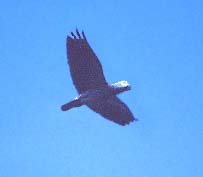
|
|
|
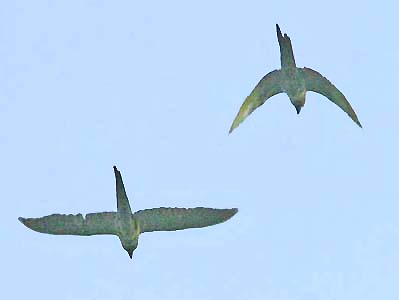
Man has had a long history of association with parrots. Obviously, keeping parrots as pets is a major hobby. Our fascination with parrots is not limited to their beauty and unique bill, but a number of species are good mimics and can be taught to "talk." The illegal trade in wild parrots has decimated some wonderful species. Spix's Macaw Cyanopsitta spixii became extinct in the wild when the last lonely male living in the wild in eastern Brazil disappeared in 2000. Fortunately, the trade in wild macaws is declining, and some populations are rebounding. Great Green Macaw (pair in flight, left), a Vulnerable species ranging patchily from Honduras to Ecuador, is now rebounding in eastern Costa Rica. Local naturalists are paying landowners to leave standing the huge wild almond (Dipteryx) trees where it nests, and have made poaching unfashionable. The macaws are responding with increased productivity. |
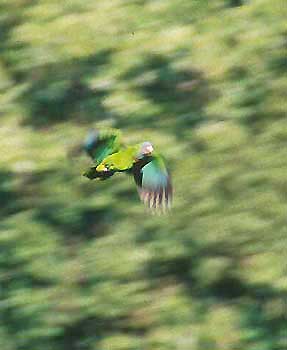
Yet many species remain threatened by this commerce. In one California-sized area of Bolivia, trappers in 1975-1984 essentially wiped out all large macaws. Collar (1997) has a fine summary of the impact on psittacines by illegal smuggling, plus the hope for the future with strengthened international laws and protocols.
In the Caribbean, four species of Amazon parrots are making comebacks as the island nations find that parrots bring in tourists. especially the four species in the Lesser Antilles: single species on St. Lucia and St. Vincent, and two on Dominica. The latter two are limited to the primeval forest on Mt. Diablotins, where the Red-necked Amazon (right) occurs at lower elevations while the rarer Imperial Amazon Amazona imperialis is up higher in the cloud forest. There are perhaps only 150 birds remaining, but the population is no longer in steep decline.
|

During our 1999 trip to Brazil, we also visited Rio Cristalino Lodge in the heart of the Amazon Basin. There we observed one of the newly described species of parrots — Kawall's or White-faced Amazon A. kawalli — which was only recognized as a different species in 1989. Along this rapidly-flowing blackwater stream it replaces Mealy Parrot, which is otherwise widespread in the steaming Amazon lowlands.
Speaking of the newly-described Kawall's Parrot reminds me of Stap's (1991) book about the LSU expeditions by John O'Neill and the late, great Ted Parker to eastern Peru: A Parrot without a Name: The Search for the Last Unknown Birds on Earth [cover shown, left]. It tells a fascinating story of avian discovery, including a new parrotlet "without a name" on a 1985 adventure [eventually described to science as the Amazonian Parrotlet Nannopsittaca dachilleae (O'Neill et al. 1991)]. |
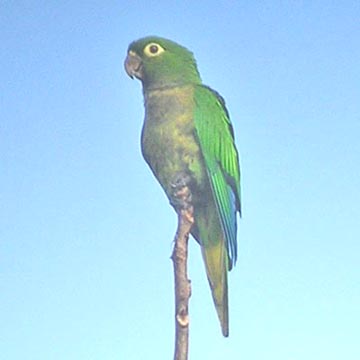
Most parrots pair for life, and form monogamous pair bonds. Courtship displays often include vocalizations and tail-fanning; the impressive Red-fan Parrot Deroptyus accipitrinus of the Amazon Basin has an erectile ruff that frames the head with bright red and blue bands.
Throughout the Neotropical forests, and the savannas and woodlands of Africa, parrots in family Psittacidae amuse and amaze. Sometimes one is awe-struck by their beauty amidst a backdrop of jungle. At other times they give us comic relief — even when the most 'basic' of parrot prototype, like this Olive-throated Parakeet in Costa Rica (right).
I can do little more here than encourage you to seek them out and to enjoy as harbingers of the wild. Here's two more: a female Red-bellied Parrot (below left) of east African — one of those "gray parrots" that are more closely related to New World parrots than Old World parrots (and thus in this family) — and the colorful and threated Cuban Amazon, endemic to Cuba. |
|
| |
Photos: The flying Scarlet Macaw Ara macao was at Rio Tigre, Osa Peninsula, Costa Rica, on 26 Dec 2007. Arthur Grosset photographed the Golden-tailed Parrotlet Touit surda was at Aquaria, Brazil, in March 2004. The Hyacinth Macaw Anodorhynchus hyacinthinus was in the Brazilian Pantanal on 5 Aug 1999. Rita Carratello was making friends with a pet Blue-fronted Amazon Amazona aestiva in the Brazilian Pantanal in August 1999. The wild Blue-fronted Amazon was in Emas NP, Brazil, on 27 Jul 2010. The Maroon-bellied Parakeet Pyrrhura frontalis was at Itatiaia NP, Brazil, on 6 Aug 2010. The Monk Parakeets Myiopsitta monachus were in the Brazilian Pantanal on 23 Jul 2010. The nesting Peach-fronted Parakeet Aratinga aurea was in the Serra de Araras, Mato Grosso, Brazil, in Aug 1999; the foraging one was in Emas NP, Brazil, on 27 July 2010. Visiting the salt lick on the Napo River, e. Ecuador (near La Selva Lodge) in Apr 1992 were Blue-headed Parrots Pionus menstruus, Mealy Parrots Amazona farinosa, and Yellow-crowned Amazons A. ochrocephala. The African Gray Parrot Psittacus erithacus was over Belinga Rd., Gabon, in July 1996. The Senegal Parrot Poicephalus senegalensis was in the Shia Hills Reserve, Ghana, in Dec 2013. The Brown-headed Parrot Poicephalus cryptoxanthus was in Kruger NP, South Africa, in Aug 1996. The pair of Great Green Macaw Ara ambigua was near La Selva, Costa Rica, on 18 Dec 2007. The Red-necked Amazon A. arausiaca was on Dominica, Lesser Antilles, on 24 Mar 2000. The Olive-throated Parakeet Aratinga nana was at La Selva Reserve, Costa Rica, on 18 Dec 2007. The Brown-headed Parrot Poicephalus rufiventris was in Tarangire NP, Tanzania, on 9 June 2018. The Cuban Parrot Amazona leucocephala was in Zapata Swamp NP, Cuba, on 8 Feb 2017.
All photos © Don Roberson, except the one attributed © Arthur Grosset and used with permission; all rights reserved.
Arthur Grosset has website filled with bird images, particularly from the tropics.
Bibliographic note:
Family book: 
Forshaw, Joseph M., and William T. Cooper. 1973. Parrots of the World. 1st ed. Landsdowne Editions, Melbourne, Australia [a compact edition was published by T.F.H. Publications, Neptune, N.J., in 1977; it is actually the book reviewed here].
Family book: Rating 
Juniper, Tony, and Mike Parr. 1997. Parrots: A Guide to Parrots of the World. Pica Press & Yale Univ. Press, New Haven, CT.
These two major family books were spaced essentially 25 years apart, and are good examples of the evolution of the "family book" in that period. The Forshaw & Cooper was a huge, oversized monograph well out of the price range of field birders; I have a "compact" edition published 4 years later. [Forshaw & Cooper have produced other tomes on birds of paradise and on kingfishers, the latter a six-volume $6,000 set.] Because of the size and the price, these books were actually aimed at book collectors -- not birders. I have never like the art, layout, or style of these vast pages with their profligate waste of white areas in the margins. The written information (by Forshaw) seemed out-of-date for many remote species when it came out, and that 1973 book I have is now almost useless when it comes to current distributional, status, or even basic biology topics for many species. [It is acknowledged that there is a new 3rd ed., published 1998, with much more up-to-date information – I have not scrutinized that text.] Yet the book did bring together quite a bit about all the parrots of the world – and had paintings of each – so was a "necessity" for anyone interested in world birding for many years. I never much liked the plates which lined up 4-6 species from widely separated regions on a single branch. One never got any feeling for the uniqueness of any particular bird, or its habitat. The artwork (by Cooper) was lovely – feather for feather – but the layout greatly diminished its impact.
The new family book by Juniper & Parr is another in the now well-known Pica Press style. Plates are bound together in one section; text (with range maps) in another. The information is, of course, much more up-to-date than the old Forshaw/Cooper (but still seemed about 5 years behind the times — the status of wild parrots is just changing too fast!). Yet the information is strictly bound into formal "sections" like "identification" and "voice" without any opening paragraph that summarizes just which niche that particular species fills, and that explains how it is identified. The plates are painted sometimes in "field guide" styles and sometimes in "mini-Cooper" style, that is, some five species of macaw from many different areas are lined up together on the same branch. Because we still lack good field guides for much of Brazil, Bolivia, central Africa, and other remote places, these books will fill a "field guide" niche for many observers. At this they are adequate (or even better than many guides), but as a worldwide "family book" the emphasis on "field guide" approach diminishes the impact of each unique bird. I have lots of little quibbles about layout, approach, and i.d. stuff in this book — so much so that I have only looked through friends' copies instead of acquiring my own.
Neither book is a "necessity" anymore. Nigel Collar's introductory text, the spectacular photos, and the fine field guide art in the parrot section of the Handbook of the Birds of the World seems superior to me. The text (Collar 1997) was as up-to-date as one could hope for the time, although all the books still lag behind on new information about birds like Kawall's Parrot, for example. The "field guide" art seems preferable to me to the "six species on one branch" layout, and the details in the written text of the species accounts appears more accurate than anywhere else. Equally important, the lavish and wonderful selection of photos finally gives one a real feeling of the specialness of these birds. There are photos of the last Spix's Macaw in the wild — along with the Blue-winged Macaw with which it was paired for some time — incredible powerful photos! If one needs to have details and art of all the world's parrots in one place, I recommend Collar (1997) over either of the separately published "family books."
Literature cited:
Christidis, L, and W.E. Boles. 2008. Systematics and taxonomy of Australian Birds. CSIRO Publ, Sydney.
Collar, N.J. 1997. Family Psittacidae (Parrots), pp. 280-477 in del Hoyo, J., A. Elliott, & J. Sargatal, eds. Handbook of the Birds of the World. Vol. 4. Lynx Edicions, Barcelona.
Cracraft, J. 2013. Avian higher-level relationships and classification: nonpasseriforms. Pp. xxi-xliii in The Howard and Moore Complete Checklist of the Birds of the World, 4th ed., Vol. 1. Non-passerines (E. C. Dickinson & J. V. Remsen, Jr., eds.). Aves Press, Eastbourne, U.K.
Dickinson, E., ed. 2003. The Howard &
Moore Complete Checklist of the Birds of the World. 3d ed. Princeton
Univ. Press, Princeton, N.J.
Dickinson, E.C., and J.V. Remsen, Jr. (eds.). 2013. The Howard and Moore complete checklist of the birds of the World. Vol. 1. Non-passerines. Aves Press, Eastbourne, U.K.
Joseph, L., A. Toon, E.E. Schirtziner, T.F. Wright, and R. Schodde. 2012. A revised nomenclature and classification for family-group taxa of parrots (Psittaciformes). Zootaxa 3205: 26-40.
O'Neill, J.P., C.A. Munn, and I. Franke. 1991. Nannopsittaca dachilleae: a new species of parrotlet from eastern Peru. Auk 108: 225-229.
Rheindt, F.E., L. Christidis, S. Kuhn, D. de Kloet, J.A. Norman, and A. Fidler. 2014. The timing of diversification within the most divergent parrot clade. J. Avian Biol. 45: 140–148.
Ridgely, R.S. 1983. Hyacinth Macaw and Brazil's Pantanal. Birding 15: 179-185.
Schweizer, M., O. Seehausen, and S.T. Hertwig. 2011. Macroevolutionary patterns in the diversification of parrots: effects of climate change, geological events and key innovations. J. Biogeography 38: 2176-2194.
Sibley, C.G., and J.E. Ahlquist. 1990. Phylogeny and Classification of Birds: A Study in Molecular Evolution. Yale Univ. Press, New Haven, CT.
Sibley, C.G., and B.L. Monroe, Jr. 1990. Distribution and Taxonomy of Birds of the World. Yale Univ. Press, New Haven, CT.
Stap, D. 1991. A Parrot without a Name: The Search for the Last Unknown Birds on Earth. Alfred A. Knopf, New York.
Whittingham, M. J., A. F. Brown, A. Drewitt, and S. Rees. 1998. Finding Hyacinth Macaw Anodorhynchus hyacinthinus in the Pantanal, Mato Grosso, Brazil. Cotinga 10: 66-67.
|
|
|

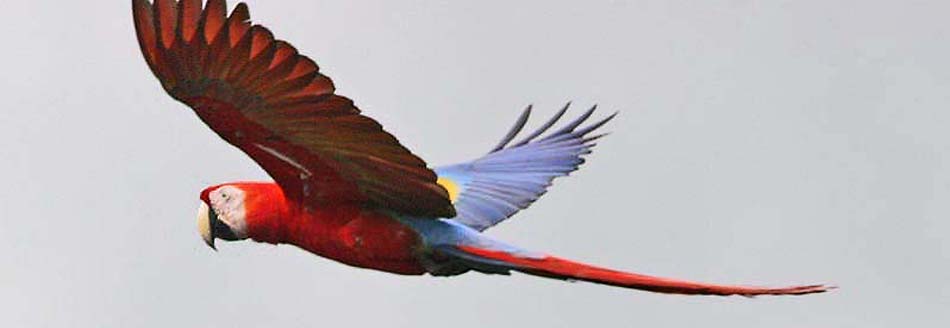
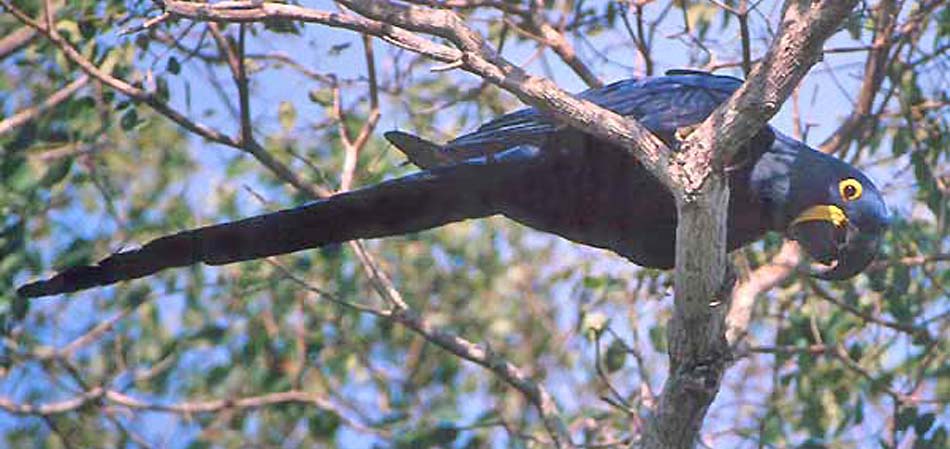
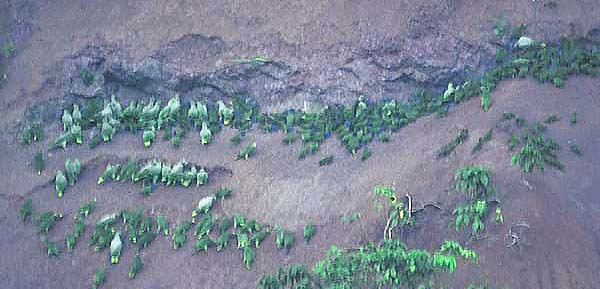
 Parrots are a very large group of easily recognized birds, generally restricted to the tropics around the globe. Recent molecular evidence could be used to group the Psittaciformes into as few as 3 or 4 families, or split them into as many as a dozen families. If one chose a three-family approach — the one that I used through 12 editions of this checklist — South American macaws were in the same family as tiny pygmy-parrots. The largest macaw is 170 times heavier and twelve times longer than one of the New Guinea pygmy-parrots (Collar 1997). This was huge family of about 330 species. Now, however, following new evidence on lineages within the parrots [e.g., Schweizer et al. 2011, Joseph et al. 2013, Rheindt et al. 2014], both Cracraft (2013) and the South American Checklist Committee (2014) have adopted a four-family solution (more details are in the shaded box below).
Parrots are a very large group of easily recognized birds, generally restricted to the tropics around the globe. Recent molecular evidence could be used to group the Psittaciformes into as few as 3 or 4 families, or split them into as many as a dozen families. If one chose a three-family approach — the one that I used through 12 editions of this checklist — South American macaws were in the same family as tiny pygmy-parrots. The largest macaw is 170 times heavier and twelve times longer than one of the New Guinea pygmy-parrots (Collar 1997). This was huge family of about 330 species. Now, however, following new evidence on lineages within the parrots [e.g., Schweizer et al. 2011, Joseph et al. 2013, Rheindt et al. 2014], both Cracraft (2013) and the South American Checklist Committee (2014) have adopted a four-family solution (more details are in the shaded box below).  The New World has but a single tribe in a single subfamily [the Arini], at least as arranged by Collar (1997), Yet among the approximately 150 species is an astonishing variety in size, shape, and behavior. About 30 species are in the widespread New World genus Amazona; these include some of the Neotropics commonest parrots and some of the world's rarest species. "Amazon" parrots are often kept as pets; indeed, in past centuries explorers coming upon previously undiscovered native inhabitants often found they kept pet parrots in their villages. At right Rita is holding a Blue-fronted (or Turquoise-fronted) Amazon which was a pet of a local family in the Brazilian Pantanal; they had found it as a baby fallen out of its nest hole and raised it to adulthood. Such parrots can live 20-30 years. The evening flight of wild Blue-fronts in the Pantanal is truly an impressive spectacle. A wild Blue-fronted Parrot is shown (below left) foraging in the canopy of a fruiting tree.
The New World has but a single tribe in a single subfamily [the Arini], at least as arranged by Collar (1997), Yet among the approximately 150 species is an astonishing variety in size, shape, and behavior. About 30 species are in the widespread New World genus Amazona; these include some of the Neotropics commonest parrots and some of the world's rarest species. "Amazon" parrots are often kept as pets; indeed, in past centuries explorers coming upon previously undiscovered native inhabitants often found they kept pet parrots in their villages. At right Rita is holding a Blue-fronted (or Turquoise-fronted) Amazon which was a pet of a local family in the Brazilian Pantanal; they had found it as a baby fallen out of its nest hole and raised it to adulthood. Such parrots can live 20-30 years. The evening flight of wild Blue-fronts in the Pantanal is truly an impressive spectacle. A wild Blue-fronted Parrot is shown (below left) foraging in the canopy of a fruiting tree. 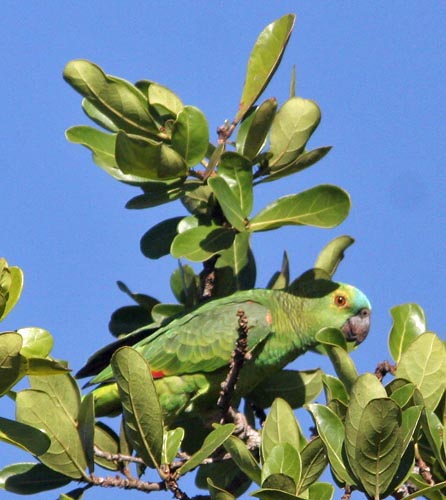
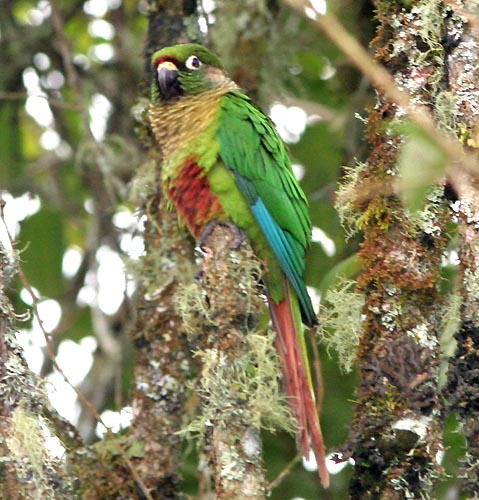
 Monk Parakeet of dry lowlands in southern South America (left) builds huge communal stick nests. Small ones may be single-chambered; huge ones have many chambers. Sometimes unused chambers are used by other species. Monk Parakeet lives in a temperate climate, and thus has sometimes fared better as an escapee in the U.S. then more tropical parrots.
Monk Parakeet of dry lowlands in southern South America (left) builds huge communal stick nests. Small ones may be single-chambered; huge ones have many chambers. Sometimes unused chambers are used by other species. Monk Parakeet lives in a temperate climate, and thus has sometimes fared better as an escapee in the U.S. then more tropical parrots. 